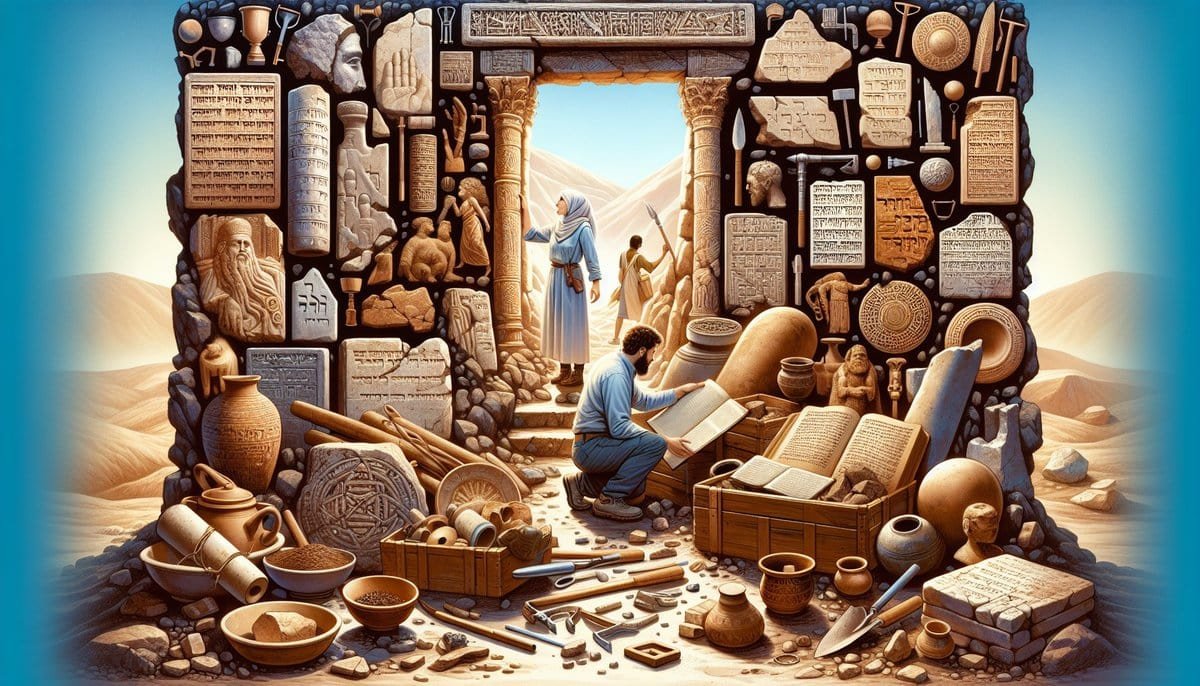In the world of Biblical Archaeology, there are several captivating excavation sites that have become popular destinations for researchers and history enthusiasts alike. These sites hold the promise of unearthing ancient artifacts and shedding light on the stories and events depicted in the Bible. With their rich history and archaeological significance, these top excavation sites are an absolute treasure trove for those passionate about uncovering the mysteries of the past.
City of David
The City of David, located in Jerusalem, is one of the most important excavation sites for biblical archaeologists. It is believed to be the original settlement of the ancient city of Jerusalem, dating back thousands of years. The site offers a unique opportunity to explore the rich history and biblical significance of this sacred city.
Archaeologists have uncovered a wealth of artifacts and structures at the City of David. Excavations have revealed ancient walls, water systems, and homes that provide valuable insights into the daily life of the people who lived here millennia ago. One of the most notable discoveries is the Pool of Siloam, mentioned in the Gospel of John, where Jesus is said to have healed a blind man.
Visitors to the City of David can walk through the ancient tunnels and streets, immersing themselves in the history and culture of Jerusalem. The site also offers a visitor center with informative exhibits that showcase the archaeological findings and explain the biblical significance of the City of David.
Megiddo
Megiddo, located in the Jezreel Valley of Israel, is another significant excavation site for biblical archaeologists. It has a long history of occupation, dating back over 6,000 years. The site is known for its strategic location and played a crucial role in numerous ancient battles.
Excavations at Megiddo have uncovered fascinating structures, such as temples, palaces, and fortifications. These findings shed light on the religious practices, governance, and military strategies of various civilizations that once thrived in the region. One of the most notable discoveries is a large Canaanite palace, thought to have belonged to the biblical King Solomon.
Visitors to Megiddo can explore the archaeological site and learn about its fascinating history and biblical connections. The expansive ruins offer a glimpse into the ancient world, and the panoramic views from the site allow visitors to appreciate the strategic importance of this location.

Tel Hazor
Tel Hazor, situated in northern Israel, is one of the largest and most significant archaeological sites in the country. It was a prominent Canaanite city and is mentioned multiple times in the Hebrew Bible. The ancient ruins at Tel Hazor provide invaluable information about the political, economic, and religious life of this ancient civilization.
Excavations at Tel Hazor have revealed impressive architectural structures, including city walls, temples, and palaces. The site also boasts a vast water system, which highlights the advanced engineering capabilities of its ancient inhabitants. These findings have enhanced our understanding of the Canaanite culture and their interactions with neighboring civilizations.
Visiting Tel Hazor allows one to explore the layers of history and witness the remnants of a once-thriving city. The site provides an excellent opportunity to appreciate the ingenuity and craftsmanship of the ancient Canaanites and their enduring impact on the region.
Jericho
Jericho, located in the Palestinian Territories, is one of the oldest continuously inhabited cities in the world. Its rich history and biblical significance make it a fascinating excavation site for biblical archaeologists. Jericho is mentioned numerous times in the Hebrew Bible, most famously for the biblical account of the walls of Jericho crumbling.
Excavations at Jericho have unearthed remnants of ancient walls, buildings, and artifacts dating back thousands of years. These findings provide insights into the daily life and cultural practices of the different civilizations that settled in Jericho over the centuries. One of the most remarkable discoveries is a tiara made of gold, believed to be from the Bronze Age.
Exploring the archaeological site of Jericho allows visitors to step back in time and witness the layers of civilization that have shaped this ancient city. The panoramic views from the site offer a breathtaking perspective of the surrounding landscape and highlight the strategic importance of Jericho throughout history.

Beit She’an
Beit She’an, located in the northern part of Israel’s Jordan Valley, is an extensive archaeological site that showcases the remains of ancient civilizations. This city has been continuously inhabited for over 6,000 years, making it a treasure trove for biblical archaeologists.
Excavations at Beit She’an have uncovered well-preserved Roman and Byzantine ruins, including temples, amphitheaters, and bathhouses. These structures offer a glimpse into the sophistication and grandeur of the ancient city. The site also features a fascinating necropolis with impressive tombs that reflect the belief systems and funeral practices of the period.
Visiting Beit She’an allows one to delve into the diverse history and cultural influences that shaped this bustling city. The impressive archaeological findings make it a must-visit destination for those interested in biblical history and ancient civilizations.
Tel Dan
Tel Dan, situated in northern Israel near the Lebanese border, is an important archaeological site renowned for its biblical significance. It is mentioned in various biblical texts and is believed to have been the northernmost city of ancient Israel. The excavations at Tel Dan have revealed a rich history that dates back thousands of years.
The most prominent discovery at Tel Dan is the Tel Dan Stele, also known as the House of David inscription. This inscription is the first archeological evidence that mentions the existence of the biblical King David outside of biblical texts. The finding provides valuable insights into the historical accuracy of biblical accounts.
Visitors to Tel Dan can explore the ruins of the ancient city, including impressive gateways and fortifications. The picturesque surroundings, with flowing streams and lush vegetation, add to the charm of the site and provide a tranquil setting for reflection and exploration.
Tel Be’er Sheva
Tel Be’er Sheva, located in the southern part of Israel, is a UNESCO World Heritage Site that holds great significance for biblical archaeologists. It is believed to be the biblical town of Be’er Sheva, mentioned in the Hebrew Bible as an important settlement in the region. The excavations at this site have uncovered layers of history spanning thousands of years.
Excavations at Tel Be’er Sheva have revealed well-preserved ancient structures, including a well-preserved water system and a well-preserved four-room house. These findings provide valuable insights into the daily life and societal organization of ancient civilizations, as well as their urban planning and infrastructure.
Visiting Tel Be’er Sheva offers a unique opportunity to explore the ancient ruins and gain a deeper understanding of the biblical accounts that mention this significant city. The visitor center on-site provides informative exhibits that further enhance the archaeological experience.
Tel Arad
Tel Arad, located in the Negev Desert of southern Israel, is an important excavation site that offers insights into the religious practices and governance of ancient Israel. The site consists of a fortress and a temple complex, providing valuable evidence of the Kingdom of Judah during the First Temple period.
Excavations at Tel Arad have revealed religious artifacts, including an intricately carved stone altar and inscriptions mentioning the names of Yahweh and the King of Judah. These findings shed light on the religious rituals and beliefs of ancient Israel and provide important historical context for the biblical texts.
Visitors to Tel Arad can explore the ruins of the fortress and gain a deeper understanding of the biblical stories that unfolded in this ancient city. The archaeological findings at the site allow for a more comprehensive understanding of ancient Israelite society and their cultural and religious practices.
Mount Sinai
Mount Sinai, located in the southern part of the Sinai Peninsula, is a significant site for both biblical archaeologists and religious pilgrims. According to biblical accounts, it is the mountain where Moses received the Ten Commandments from God. The mountain remains a revered place for those of the Jewish, Christian, and Islamic faiths.
Although the exact location of Mount Sinai remains debated, pilgrims and scholars continue to visit the site in hopes of uncovering archaeological evidence to support the biblical narrative. The rugged, awe-inspiring landscape adds to the sense of spirituality and reverence associated with this sacred mountain.
While no specific archaeological remains have been definitively linked to the biblical account of Mount Sinai, exploring the mountain’s surroundings allows visitors to connect with the rich religious and historical traditions that have been passed down through generations.
Qumran
Qumran, located near the Dead Sea in the West Bank, gained worldwide fame with the discovery of the Dead Sea Scrolls in 1947. These ancient texts, written between the 3rd century BCE and the 1st century CE, provide invaluable insights into Jewish religious practices and biblical interpretations during the Second Temple period.
The archaeological site of Qumran was inhabited by a Jewish sect known as the Essenes, who are believed to have authored and stored the Dead Sea Scrolls in the nearby caves. Excavations have uncovered ritual baths, living quarters, and a large dining hall, shedding light on the unique lifestyle and religious beliefs of this community.
Visiting Qumran offers a chance to explore the ruins of this ancient settlement and gain a deeper understanding of the context in which the Dead Sea Scrolls were written. The nearby caves, where the scrolls were discovered, are also worth exploring for those interested in the ancient textual treasures.
In conclusion, the top excavation sites for biblical archaeologists offer a unique opportunity to delve into the rich history and biblical significance of the ancient world. From the City of David in Jerusalem to Qumran near the Dead Sea, each site provides valuable insights into the civilizations and cultures that shaped the biblical narrative. Whether exploring ancient cities, unearthing religious artifacts, or seeking connections to biblical accounts, these excavation sites provide a fascinating journey through time and a deeper understanding of our shared human heritage.






